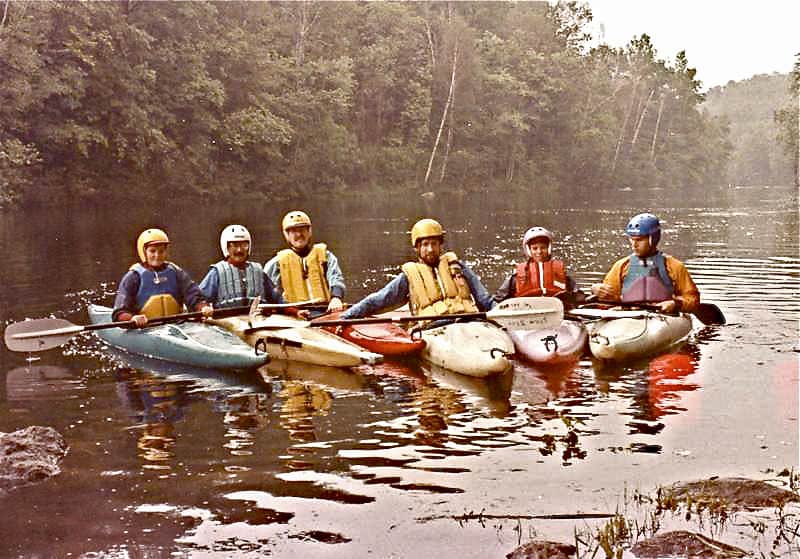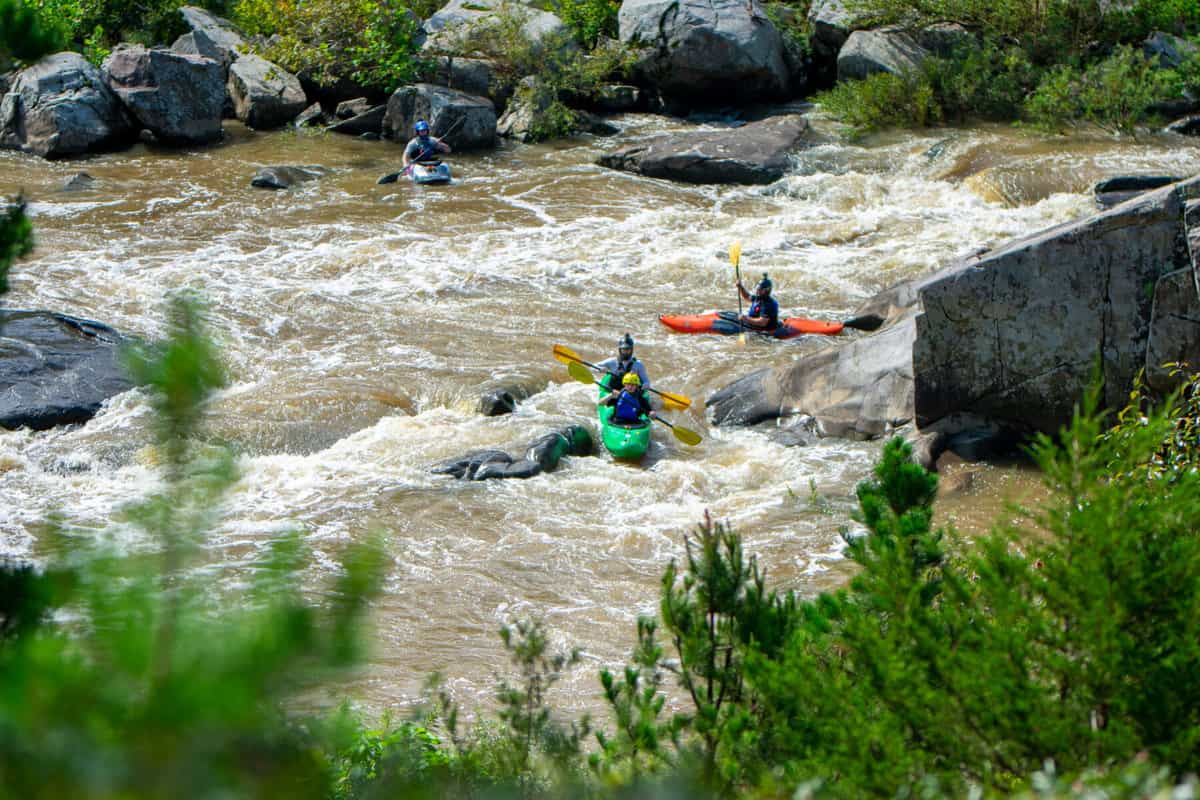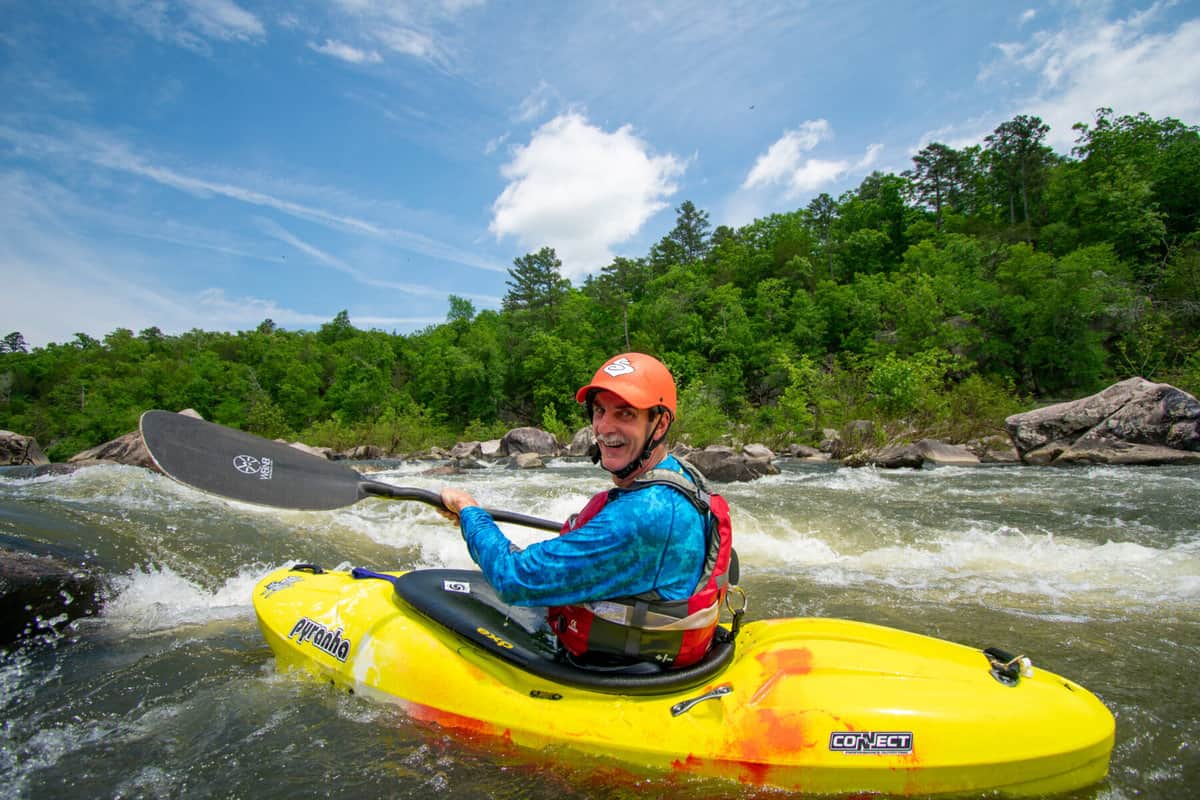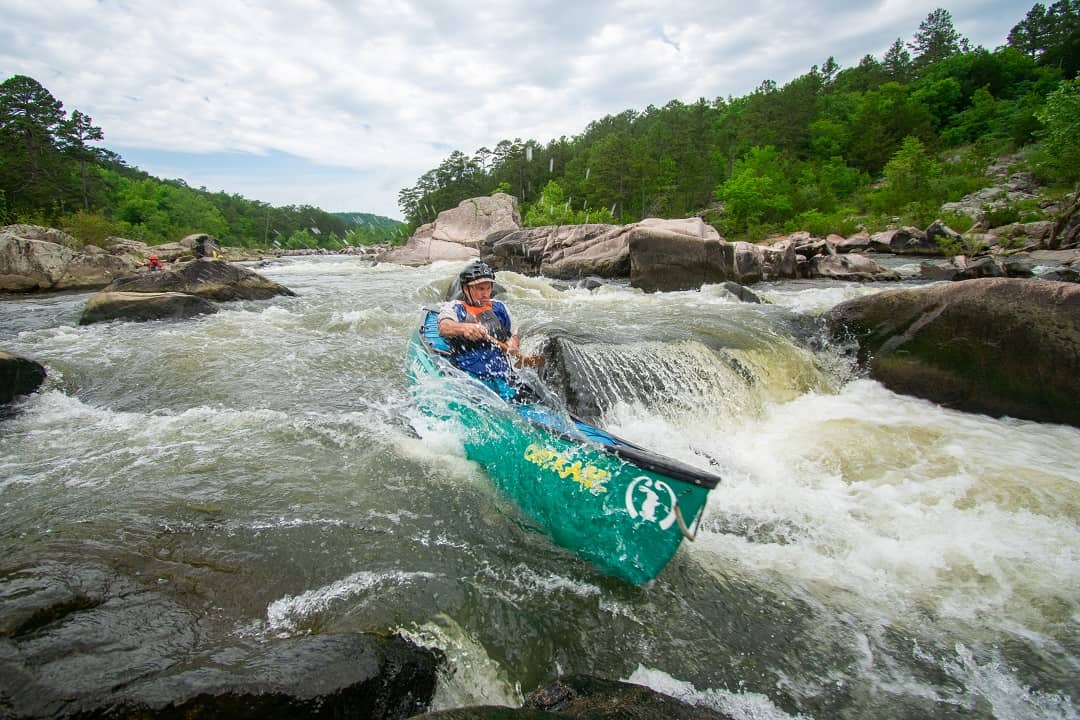Community. It is the beating heart of the outdoor sports we hold dear. It exists in the people and places we turn to when we crave a sense of belonging and seek respite from the daily grind. It lives and breathes and grows.
And, right here in Missouri, we boast one of the most unlikely and distinctive outdoor communities you will find anywhere in the country. You see, the Ozarks have numerous creeks and rivers that are floatable year-round, but most of the whitewater in the region is rain-dependent and temperamental. To be part of the whitewater scene in Missouri is to be patient, hopeful, fearless, creative. Our whitewater scene defies the odds of how and where such a community should thrive.
But rather than jump in midstream, let’s take this story back to the start as we flow through the history of whitewater canoeing and kayaking in Missouri.
Back Where it All Begins
Ethnologists commonly agree that the name Missouri derives from native terms that translate to “canoe people” or “town of the large canoes.” Indigenous inhabitants in the Ozarks had been using canoes and other watercraft for tens of thousands of years before the history of modern paddling began, for transportation, trade, and fishing.
While these early experiences undoubtedly included a lot of enjoyment, it is difficult to find any recorded documentation of recreational activity on Missouri whitewater until the 1950s. And so, our story jumps forward to the years following World War II.
The industries that developed in support of the war effort found themselves in possession of new materials such as aluminum, synthetic rubber, and fiberglass, which proved to be very suitable in constructing watercraft to explore some of the more difficult stretches of rivers around the country. Though small groups of adventure-seekers had been using various methods for river exploration throughout the early 1900s, it was during the post-war 1950s and ’60s that whitewater sports began to gain national attention.
This is where the history of recreational whitewater in Missouri really begins.
The Early Years: The ’50s-’60s
Oz Hawksley was a Missourian who had a passion for wild rivers. As a professor at Central Methodist University in Fayette, he introduced several generations of students to river running, backpacking, and spelunking through field trips and inspired many of his students to pursue environmental careers.
Hawksley was one of the founding members of American Whitewater, a nonprofit dedicated to protecting and restoring America’s whitewater rivers and to enhancing opportunities to enjoy them safely. The organization was created in 1954 and incorporated in Missouri in 1961.

An early flotilla of fun in Missouri.
Hawksley’s articles in the American Whitewater journal throughout the ’50s and ’60s focused on wilderness conservation, prevention of new dams, wild and scenic river protection, and the establishment of the Land and Water Conservation Fund, which continues to preserve our waterways to this day. He also authored the guidebook Missouri Ozark Waterways and started the Ozark Wilderness Waterways Club in 1956.
Around the same time Hawksley was doing his thing in central Missouri, St. Louis-area paddlers formed a group called the Meramec River Canoe Club (MRCC). According to longtime member Al Beletz, who wrote a book on the now-defunct organization along with his brothers Syl and Frank, the MRCC was thriving unofficially as early as the 1930s. It was incorporated as a club in 1965 and met regularly until the later 1970s.
As its name suggested, the MRCC focused on recreational canoeing in the Meramec River region. The club originally had many members who were interested in canoe poling (using a long pole instead of a paddle to navigate while standing in the canoe), and they hosted canoe poling races on the Meramec. These canoe poling enthusiasts grew into the beginnings of a whitewater community.
The first Missouri Whitewater Championships were hosted by the MRCC and held in 1968 on the St. Francis River near the old mining town of Ironton. The MRCC eventually evolved into the Arnold Canoe Club, which then grew to become the Missouri Whitewater Association (MWA). Today, most whitewater paddlers in Missouri are introduced to the sport through the MWA.
Growing and Evolving: The ’70s-’80s
While these groups were growing and evolving upstate, Ted Gearing was paddling with friends in the Springfield area. He started the sport in the mid-’70s in southwest Missouri and northwest Arkansas, often hooking up with folks from the Arkansas Canoe Club and the Buffalo Outdoor Center in Ponca, Arkansas.
In the early ’80s, he became a founding member of another whitewater group in southern Missouri called the Ozark Mountain Paddlers. Gearing has vivid memories of the organization’s first meeting at the store Taum Sauk Outfitters. There had been no other “official” paddling club in southern Missouri, and that first meeting drew more than 100 people, many of them families and entry-level boaters. However, after the club showed videos of some intense whitewater at the initial gathering, only 10 people showed up for the second.

Kayaks navigating Cat’s Paw rapids on the St. Francis River. (John Holdmeier, Actual Outdoors)
The whitewater culture in Missouri was still developing. Prior to the late ’70s, most whitewater gear still came from army surplus stores or was a mix of homemade and DIY equipment. Kevin Olsen, a MWA member who has been paddling since those days, recalls “old high-float PFDs, hockey helmets, fiberglass boats, and handmade wooden paddles.” He also remembers what the community was like when he first showed up on the scene. “The Ozarks were a wild place back then,” he said.
The late ’70s and ’80s saw gear improvements, with plastic watercraft popping up in regional outdoor stores such as Backwoods Outfitters, Alpine Shop, and Adventure Sports Shop. Before plastic, whitewater gear had mostly been aluminum canoes and a spattering of fiberglass kayaks. The problem with fiberglass and rocks should be fairly self-explanatory; once plastic kayaks were introduced, paddlers were able to spend less time patching their boats and more time improving their skills.
The Missouri whitewater scene had by that time developed a clear epicenter: The St. Francis River, also known as the Saint, with a shut-in style riverbed and a large watershed drawing from the St. Francois Mountains. The parking lot at the take-out here has served as a gathering point for the local whitewater community since the first Missouri Whitewater Championships in the ’60s.
The newfound freedom afforded by purpose-made, plastic whitewater boats allowed our local community of boaters to begin exploring beyond the relative “comfort” of home, and the late ’80s saw paddlers traveling to test harder whitewater in neighboring states and also turning their sights to the local Missouri creeks that were tougher and steeper than the Saint.
First Descents: The ’90s
Avid paddler Chris Amelung remembers the early ’90s fondly. During this time, he was first introduced to whitewater kayaking on the Saint near his home in Ironton. He recalls joining a whitewater community that was welcoming and full of excitement about exploring the local Missouri rivers and creeks.

Bill “Bilbo” Eads on the St. Francis River in Missouri. (John Holdmeier, Actual Outdoors)
During his first months, Amelung split time between practicing at a local pool and building his skills on the Saint with another experienced kayaking local named Chuck McHenry. They started venturing beyond the Saint and became more serious about discovering new creeks that had never been paddled before.
In the paddling world, one of the most sought-after experiences is the “first descent” — being the first person to successfully navigate a new whitewater run. Amelung and his crew of local paddlers spent the early ’90s studying topographical maps and driving to trailheads in search of the next new creek to paddle. This seek-and-conquer aspect of paddling was “at least half the fun,” said Amelung, who was enamored with this new way of exploring his home environment.
The ’90s and early 2000s in southern Missouri were a sweet spot for first descents of steep creeks like Mud Creek (a tributary of the Saint) and Carver Creek and Lower Rock Creek in southeast Missouri. Many veteran whitewater paddlers in our area look back at these days warmly and remember how it felt wondering “what was around the next bend?
Current Matters: 2010-present
While the ’90s and early 2000s were a golden age of exploration for the whitewater scene in the Missouri Ozarks, the years since have proved to be just as exciting. The MWA is stronger than ever, having grown its reach and membership. The organization still produces the Missouri Whitewater Championships every March and also provides an instructional clinic each May, plus other training, trips, and events throughout the year.
Still centered largely on the Saint, our Missouri whitewater scene has come a long way from its humble beginnings. The community has increased river access for thousands, has launched the careers of many professional kayakers, and has created waves throughout the paddle sports industry.
Some of the characters I’ve mentioned in this story are probably in the Saint parking lot even now, trading tall tales or arguing over shuttle logistics. The Missouri whitewater scene has always been a small group of people compared to other national paddling communities, and this is exactly what makes it such a close-knit crew, with a deep appreciation for what we have in our rivers.
As a member of this community myself, I will always look back on my years of paddling with an overwhelming sense of gratitude for the original Ozark whitewater pioneers.
Author: John Holdmeier is a contributor to Terrain Magazine.
Top Image: Running the rapids on the St. Francis River in Missouri. (John Holdmeier, Actual Outdoors)


Great article
I think the university cited in regard to Oz Hawsley might be incorrect